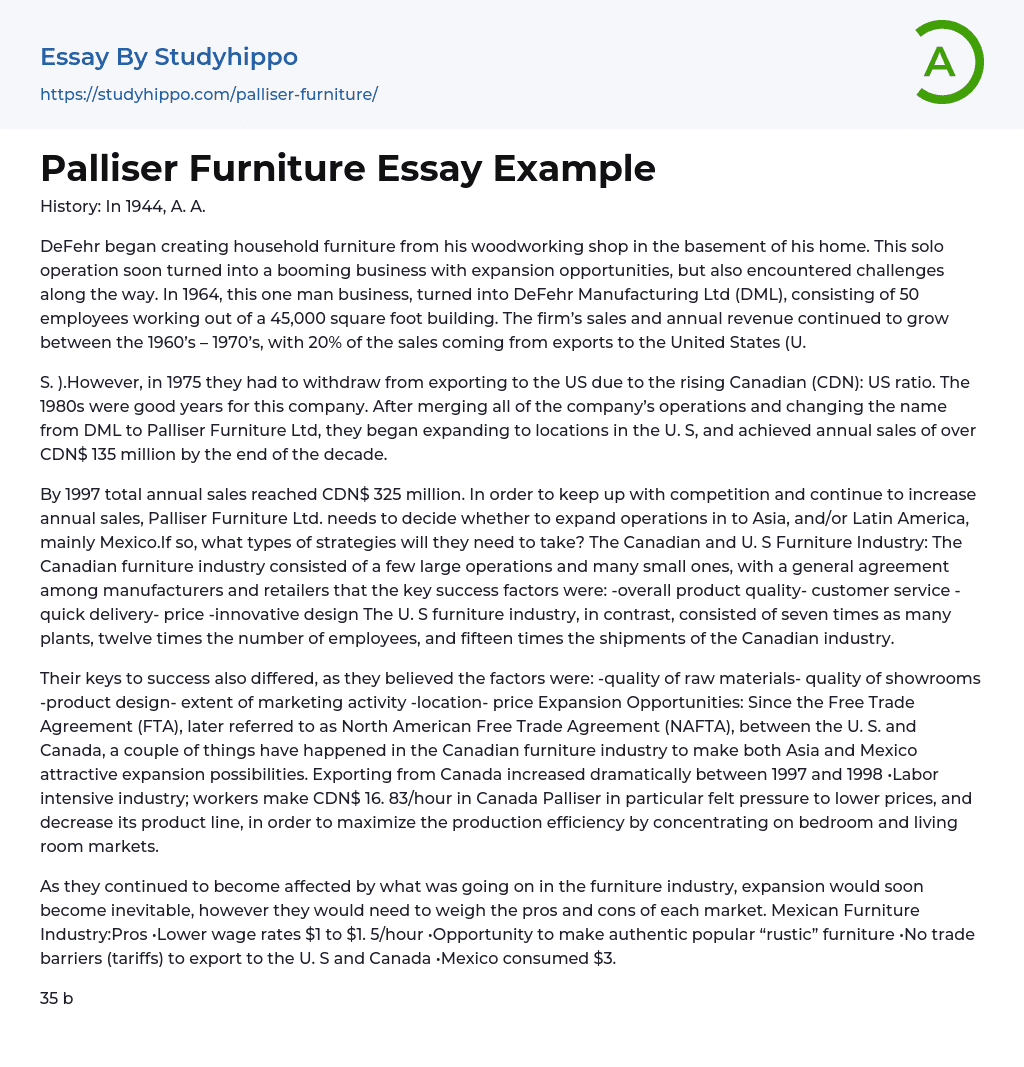
In 1944, A. A. DeFehr began creating household furniture from his woodworking shop in the basement of his home. This solo operation soon turned into a booming business with expansion opportunities, but also encountered challenges along the way. In 1964, this one man business, turned into DeFehr Manufacturing Ltd (DML), consisting of 50 employees working out of a 45,000 square foot building. The firm’s sales and annual revenue continued to grow between the 1960’s – 1970’s, with 20% of the sales coming from exports to the United States (U. S. ).
However, in 1975 they had to withdraw from exporting to the US due to the rising Canadian (CDN): US ratio. The 1980s were good years for this company. After merging all of the company’s operations and changing the name from DML to Palliser Furniture Ltd, they began expanding to locations in the U. S, and achieved annu
...al sales of over CDN$ 135 million by the end of the decade.
By 1997 total annual sales reached CDN$ 325 million. In order to keep up with competition and continue to increase annual sales, Palliser Furniture Ltd. needs to decide whether to expand operations in to Asia, and/or Latin America, mainly Mexico.If so, what types of strategies will they need to take? The Canadian and U. S Furniture Industry: The Canadian furniture industry consisted of a few large operations and many small ones, with a general agreement among manufacturers and retailers that the key success factors were:
- overall product quality
- customer service
- quick delivery
- price
- innovative design
The U. S furniture industry, in contrast, consisted of seven times as many plants, twelve times the number of employees, and fifteen times
the shipments of the Canadian industry.
Their keys to success also differed, as they believed the factors were:
- quality of raw materials
- quality of showrooms
- product design
- extent of marketing activity
- location
- price.
Expansion Opportunities: Since the Free Trade Agreement (FTA), later referred to as North American Free Trade Agreement (NAFTA), between the U. S. and Canada, a couple of things have happened in the Canadian furniture industry to make both Asia and Mexico attractive expansion possibilities. Exporting from Canada increased dramatically between 1997 and 1998 •Labor intensive industry; workers make CDN$ 16. 83/hour in Canada Palliser in particular felt pressure to lower prices, and decrease its product line, in order to maximize the production efficiency by concentrating on bedroom and living room markets.
Palliser should definitely consider making an immediate investment before any of their competitors. However, that does not necessarily mean that should rule out expansion into China. The quality of Chinese furniture products is continuing to improve, and soon Palliser’s consumers would be purchasing them.
Perhaps Palliser could compete with the Chinese competitors by increasing their leather products, since that is where they have a competitive advantage. They could also enter into joint ventures with Chinese manufacturers for making leather products and other lower cost products for exporting to other markets, such as Europe, Japan, Australia, etc. Mexico appears to be the best investment in the present time, but Palliser should continue to consider China in their mid to long term plans.
- Accounting essays
- Marketing essays
- Automation essays
- Business Cycle essays
- Business Model essays
- Business Operations essays
- Business Software essays
- Corporate Social Responsibility essays
- Infrastructure essays
- Logistics essays
- Manufacturing essays
- Multinational Corporation essays
- Richard Branson essays
- Small Business essays
- Cooperative essays
- Family Business essays
- Human Resource Management essays
- Sales essays
- Market essays
- Online Shopping essays
- Selling essays
- Strategy essays
- Management essays
- Franchising essays
- Quality Assurance essays
- Business Intelligence essays
- Corporation essays
- Stock essays
- Shopping Mall essays
- Harvard Business School essays
- Harvard university essays
- Trade Union essays
- Cooperation essays
- News Media essays
- Waste essays
- Andrew Carnegie essays
- Inventory essays
- Customer Relationship Management essays
- Structure essays
- Starting a Business essays
- Accounts Receivable essays
- Auditor's Report essays
- Balance Sheet essays
- Costs essays
- Financial Audit essays
- International Financial Reporting Standards essays
- Tax essays
- Accountability essays
- Cash essays
- Principal essays



